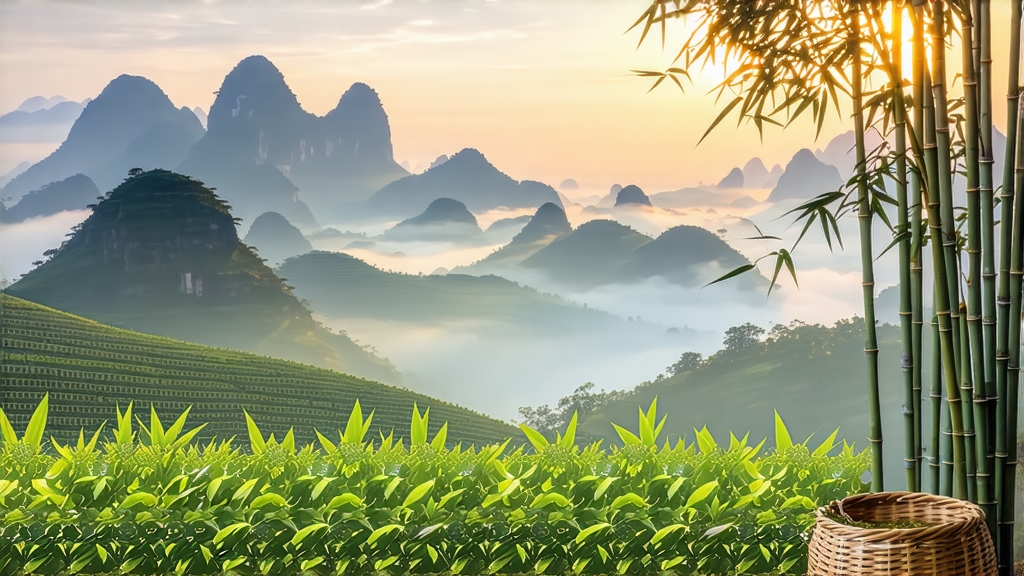
Tucked high above the Sichuan basin, where the Min River carves clouds into the slopes of Mt. Meng, a tea once reserved for Tang-dynasty emperors still unfurls its golden needles each April. Meng Ding Huang Ya—literally “Yellow Bud from the Summit of Meng”—is the least-known yet most aristocratic member of China’s tiny yellow-tea family. While green tea dominates export shelves and pu-erh fills investment vaults, this yellow bud survives in a fragile ecological and cultural niche, its annual production smaller than a single Bordeaux vineyard. To understand it is to step into a six-century time capsule of scent, myth and micro-climate.
History: from altar to anonymity
The first written record appears in 808 CE, when the monk Shi Ju presented “meng shan shi hua” (stone-flower of Meng Mountain) to Emperor Xianzong. By the Song dynasty the tea had become a fixed item on the imperial altar of Heaven, freighted with the belief that the mountain’s perennial mist was “heavenly breath” capable of translating into longevity. When Ming Hongwu rulers abolished compressed tribute cakes in 1391, leaf-style Meng Ding Huang Ya replaced them, travelling 2 400 km by horse and canal to Beijing within 21 days so that the emperor could taste the spring equinox in every cup. After the 1911 revolution the tribute system collapsed; farmers switched to faster-paying green teas, and yellowing knowledge survived only in the memory of three families in the village of Ganxi. Rediscovery came in 1959 when the Sichuan Academy of Agricultural Sciences sought a flagship gift for the upcoming tenth National Day. A retired tribute-tea master named Yang Ziqing was located, still able to recite the 18-hour yellowing chant. Small-batch production resumed, yet even today fewer than 2 000 kg leave the mountain each year.
Micro-terroir: why the mountain makes yellow possible
Mt. Meng rises 1 456 m within one degree of the 30th parallel north, trapping a 280-day fog belt that filters 38 % of direct sunlight. The result is a tender, amino-acid-rich leaf—typically 4.2 % theanine, almost double that of lowland Sichuan greens—ideal for the slow enzymatic oxidation that defines yellow tea. Soils are Devonian sandstone leached by 2 200 mm annual rainfall, creating a porous, slightly acid matrix (pH 5.1) that forces bushes to send roots laterally, absorbing rare earth elements that translate into a subtle petrichor note in the finished tea. Only three ancient cultivars—Mengding Ganzhu, Mengding Shixian and the newly stabilised Mengding Huang 1—are judged capable of withstanding the mountain’s 15 °C diurnal swing without collapsing into grassy astringency during yellowing.
Plucking: the one-bud, one-leaf equinox rule
Harvest opens on the first monkey-call of dawn after the spring equinox and closes when peach petals drift across the stone paths—usually a 12-day window. Pickers must snap the shoot at precisely 2.5 cm, the moment the second leaf is 70 % unfurled, ensuring a internal moisture gradient that will drive the subsequent “men huang” (sealed yellowing) stage. Experienced pluckers work barefoot so as not to bruise leaf edges on the basket rim; a full day’s haul for one person is 600 g fresh weight, yielding barely 120 g finished tea.
Craft: the 48-hour choreography of smoke and silence
Yellow tea is often described as “green tea with an extra nap,” but the nap is a high-wire act between oxidation and fermentation. Meng Ding Huang Ya follows a sequence unchanged since Yang Ziqing’s notes:
-
Sha Qing (kill-green) over mountain-cane charcoal
Leaves are tumble-tossed for 3.5 minutes in a 160 °C wok whose surface has been smoked with fresh-cut cane, imparting a whisper of molasses that will later marry with the yellowing aromatics. The goal is 62 % moisture retention—higher than green tea—leaving enzymes alive for the next step. -
Re-wrap Re-bake (Men Huang) inside fresh bamboo membrane
Immediately after wok exit, the hot leaf is piled 8 cm deep inside a cylinder woven from one-year-old Phyllostachys bamboo whose inner membrane is still moist. The cylinder is slid into a 38